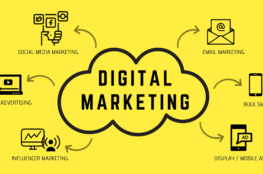Content marketing involves creating and sharing valuable, relevant content to attract and engage a target content from an audience. It focuses on building trust and educating potential customers through blogs, videos, infographics, and others. Instead of directly promoting products, content marketing aims to offer useful information that naturally leads consumers toward the brand.
This strategy helps brands establish authority, create lasting relationships, and improve online visibility, which can result in increased organic traffic and conversions.
What is Search Engine Optimization (SEO)?
SEO focuses on optimizing content and website structure to improve visibility in organic search engine results. By incorporating targeted keywords, improving on-page elements, and building backlinks, SEO ensures that content is easily discoverable by search engines. Effective SEO practices enhance user experience, build credibility, and drive long-term traffic.
When combined with content marketing, SEO ensures that the content reaches the intended audience, leading to higher rankings and greater online visibility.
For example, Digital Vibes offers comprehensive SEO services that help businesses enhance their online presence by optimizing their websites for better search engine rankings.
Pros of Content Marketing
- Cost-Effective: Content marketing is more affordable than traditional marketing methods and delivers long-lasting results.
- Builds Trust and Authority: Offering valuable information builds trust with your audience and positions your brand as an industry leader.
- Boosts SEO: High-quality content improves your SEO efforts, driving more organic traffic and better rankings in search results.
Cons of Content Marketing
- Time-Consuming: Producing consistent, high-quality content requires time and effort.
- Results Take Time: Unlike paid advertising, content marketing takes time to show significant results, as it focuses on long-term growth.
Key Components of a Content Marketing Strategy
- Define Your Audience: Identifying your target audience is essential. Understanding their pain points and interests helps in creating relevant content that resonates with them.
- Content Creation: Develop content that addresses your audience’s needs, whether through blogs, videos, or infographics. Each piece should provide value and encourage engagement.
- Content Distribution: Once content is created, distributing it through the right channels (social media, email marketing, SEO) ensures it reaches the right audience.
- Measure Performance: Analyze key metrics such as engagement, traffic, and conversions to assess the effectiveness of your content strategy.
Setting Up a Content Marketing Campaign
Launching a successful content marketing campaign requires a well-thought-out plan. Begin by outlining clear objectives, such as increasing brand awareness, driving traffic, or generating leads. Conduct keyword research to ensure your content is optimized for search engines, which can help boost visibility. Develop a content calendar to organize and schedule posts, ensuring consistency in content delivery. Lastly, use analytics tools to monitor performance and adjust your strategy accordingly for optimal results.
Setting Up a Content Marketing Campaign
Regularly measuring the success of your content marketing efforts is essential for making data-driven decisions. Focus on metrics such as page views, time spent on a page, bounce rates, and social media shares. Additionally, assess how content impacts conversion rates by tracking lead generation and sales. These insights will help you optimize your strategy, improve weak areas, and maximize the return on investment (ROI).
Common Mistakes to Avoid in Content Marketing
- Lack Of Consistency Inconsistent posting can result in a loss of audience interest. Establishing and following a content calendar is key to maintaining regular engagement.
- Focusing Only On Quantity: While creating more content can seem productive, focusing on quality is more important. High-quality, informative content will yield better long-term results.
- Neglecting SEO: Content without proper SEO optimization can go unnoticed. Ensure that your content is optimized with relevant keywords and follows best SEO practices for maximum visibility.
Integrating Content Marketing with Other Channels:
Content marketing becomes more powerful when integrated with other marketing strategies. Social media platforms are excellent channels to promote your content and drive engagement. Similarly, combining content marketing with email campaigns helps nurture leads and retain customers. SEO and content marketing work hand-in-hand to improve organic reach, while paid advertising can amplify the visibility of key pieces of content.
By using a multi-channel approach, you create a unified brand experience, which helps reach a larger audience and enhance engagement.
Budgeting For Content Marketing:
Allocating a budget for content marketing depends on your business goals. Begin by determining how much content you need to create, whether it’s blog posts, videos, or infographics. Set aside a portion of the budget for content distribution, whether through social media advertising or SEO services. Tools for content creation and analytics will also require investment. Keep in mind that while content marketing might require upfront costs, the results yield long-term benefits that often far outweigh the initial investment.
Personalization and Targeting
With advancements in technology, personalization in content marketing has become essential. Understanding your audience’s preferences allows you to tailor your content to meet their specific needs. Personalized emails, targeted ads, and content that addresses individual pain points can significantly increase engagement and conversion rates. Utilizing data analytics tools to gather insights on your audience’s behavior can aid in crafting personalized content strategies.
Moreover, leveraging customer feedback and engagement metrics is crucial in refining your personalized marketing approach. By actively listening to your audience through surveys, social media interactions, and direct feedback, you can gain valuable insights into their evolving needs and interests. This continuous feedback loop enables you to adapt your content and marketing tactics in real time, ensuring that your messaging remains relevant and effective.
Additionally, incorporating automation tools can enhance your personalization efforts while saving time and resources. Automation platforms allow marketers to segment their audience based on specific criteria, such as demographics or past behavior, enabling the delivery of tailored content at scale. By automating personalized campaigns, businesses can maintain a consistent and engaging presence across multiple channels, ultimately driving higher conversion rates and fostering long-term customer loyalty.
The Role of Visual Content
In today’s fast-paced digital landscape, visual content is more important than ever. Incorporating images, videos, infographics, and interactive content can enhance user engagement. Research shows that articles with images receive 94% more views than those without. Engaging visuals not only break up large blocks of text but also helps convey complex information more clearly, making it easier for audiences to digest your message.
User-Generated Content (UGC)
User-generated content is an effective way to engage your audience and build community around your brand. Encouraging customers to share their experiences with your products or services on social media can generate authentic content that boosts credibility. Featuring UGC in your marketing strategy not only showcases customer satisfaction but also promotes a sense of belonging among your audience.
Leveraging Analytics for Continuous Improvement
Regularly analyzing the performance of your content is vital for continuous improvement. Use tools like Google Analytics to track metrics such as traffic sources, user behavior, and conversion rates. By understanding which types of content perform best, you can refine your strategy, allocate resources more effectively, and focus on creating content that resonates with your audience.
In addition to quantitative metrics, consider gathering qualitative feedback through surveys or user comments. This feedback can provide deeper insights into your audience’s preferences and pain points, allowing you to tailor your content more precisely. By combining data analysis with audience input, you can enhance the relevance and impact of your content, ultimately driving greater engagement and conversions.
Integrating Emerging Technologies
Staying ahead in content marketing also means embracing emerging technologies. Artificial Intelligence (AI), virtual reality (VR), and augmented reality (AR) are transforming how brands interact with consumers. For example, AI can assist in content creation and personalization, while VR and AR can provide immersive experiences that captivate audiences. Integrating these technologies can set your brand apart and enhance the overall customer experience.
Moreover, utilizing AI-driven analytics can provide valuable insights into consumer behavior, enabling you to tailor your content strategy based on real-time data. This can lead to more effective targeting and higher engagement rates, as you can deliver the right message to the right audience at the right time. Analyzing vast amounts of data quickly allows brands to stay agile and responsive to market trends.
Incorporating VR and AR into your marketing efforts can also elevate brand storytelling. By creating interactive and engaging narratives, you can forge stronger emotional connections with your audience. This not only boosts brand loyalty but also encourages sharing and word-of-mouth promotion, further amplifying your content’s reach. As these technologies continue to evolve, being an early adopter can position your brand as a leader in innovation, attracting tech-savvy consumers looking for unique experiences.
Building a Content Distribution Strategy
Creating great content is only part of the equation; distributing it effectively is equally important. Develop a distribution strategy that includes various channels such as social media, email newsletters, and partnerships with influencers or other brands. Collaborating with industry influencers can help amplify your message and introduce your content to a broader audience, increasing brand awareness.
Additionally, consider leveraging paid advertising to boost your content’s visibility. Platforms like Facebook, Instagram, and LinkedIn offer targeted advertising options that allow you to reach specific demographics based on interests, behaviors, and location. This targeted approach can enhance your content’s reach and drive more qualified traffic to your website. Furthermore, regularly evaluating the performance of your distribution channels will enable you to optimize your strategy over time, ensuring that you allocate resources to the most effective platforms for engaging your audience.
Final Thoughts on Future Trends
The content marketing landscape is ever-evolving, and brands must remain vigilant to keep up with the rapid pace of change. Staying informed about emerging trends, such as voice search optimization, video marketing, and interactive content, is essential for adapting your strategy to meet the demands of today’s consumers. For instance, with the rise of smart speakers and voice-activated devices, optimizing your content for voice search can significantly improve your visibility and accessibility. This involves focusing on conversational keywords and providing clear, concise answers to common queries, ensuring your content resonates with users who prefer voice search.
Also check – Why Go with Digital Marketing in 2024 to Grow Your Business?



